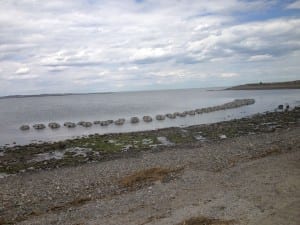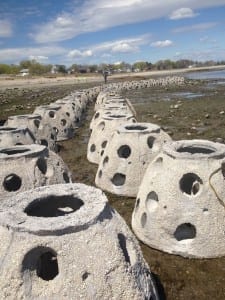In 2011, All Habitat Services created a dune as part of a coastal restoration project. The dune stretches across 900 feet of the beach at Stratford Point to stabilize and protect the shoreline from erosion.
Our dune was constructed using Filitrexx Safety Soxx Filter Socks (geotextile tubes) filled with sand and soil, erosion control blankets, a drainage swale and check dams. Upon completion of construction, we hand-planted 38,000 American Beach Grass plantings on top of the dune to aid in the stabilization which we then surrounded with fencing.
During Hurricane Sandy, the dune aided in prevention of major erosion of the shoreline and other inland areas. Although the storm washed away the dune’s sand and vegetation, the base of our dune remained intact and the shoreline relatively unaffected. Our dune remains a key part of the ecosystem protection and restoration at Stratford Point.
The first project of its kind in Connecticut and the northeast, All Habitat Services was a part of the largest installation of an artificial reef at Stratford Point in 2013.
Stratford wanted to place artificial reef balls along the shoreline to act as a buffer and protect ocean wildlife. Creation of the reef resided in a roughly 3.5 acre inertidal zone at the coastal estuary restoration site managed by CAS at Stratford Point.
All Habitat Services worked alongside with DuPont, Sacred Heart, and the CT Audubon Society in this innovative project to improve critical habitat, improve coastline stability from storm erosion and sea level rise, as well as restore the salt marsh behind the reef. The newly created shoreline breaks up waves and storm surges, allowing for sediment accumulation and for protective tidal marsh plants to cultivate. This habitat creation also allows for a natural community of fish, blue crab and shellfish to emerge. In addition, the area enhances the environment for Egrets, Herons, and other birds.
 The reef construction consisted of 40 permeable concrete reef balls in four rows of ten. Reef balls are essentially dome-like structures of various size, ranging from 2 feet tall with a 3 foot diameter base to 9 inches tall with a 17 inch diameter base. The reef balls, manufactured by the non-profit Reef Ball Foundation, contain holes which allow water, sediment, and marine organisms to travel through.
The reef construction consisted of 40 permeable concrete reef balls in four rows of ten. Reef balls are essentially dome-like structures of various size, ranging from 2 feet tall with a 3 foot diameter base to 9 inches tall with a 17 inch diameter base. The reef balls, manufactured by the non-profit Reef Ball Foundation, contain holes which allow water, sediment, and marine organisms to travel through.
All Habitat Services was grateful to be involved in such a ground-breaking project that protects the shoreline, improves natural habitat, and strengthens biodiversity in the Housatonic River estuary.


